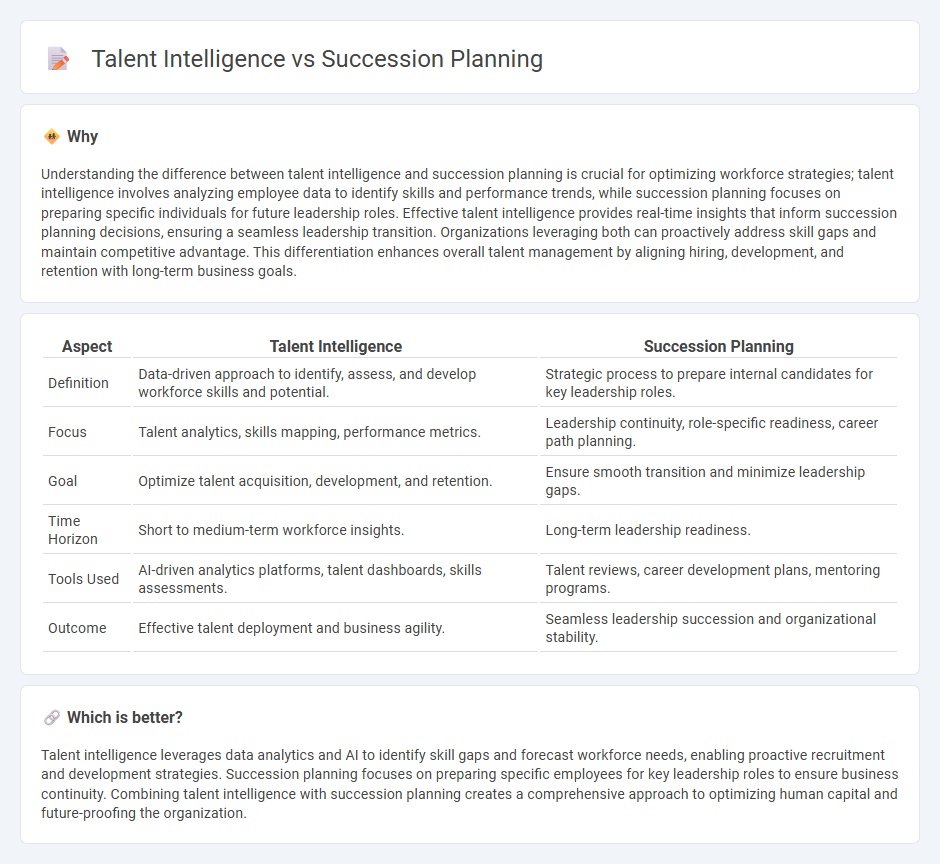
Talent intelligence leverages data analytics and workforce insights to identify skill gaps and forecast talent needs, enhancing recruitment and retention strategies. Succession planning focuses on developing internal candidates to fill key leadership roles, ensuring business continuity and leadership stability. Explore how integrating talent intelligence with succession planning can optimize talent management and drive organizational success.
Why it is important
Understanding the difference between talent intelligence and succession planning is crucial for optimizing workforce strategies; talent intelligence involves analyzing employee data to identify skills and performance trends, while succession planning focuses on preparing specific individuals for future leadership roles. Effective talent intelligence provides real-time insights that inform succession planning decisions, ensuring a seamless leadership transition. Organizations leveraging both can proactively address skill gaps and maintain competitive advantage. This differentiation enhances overall talent management by aligning hiring, development, and retention with long-term business goals.
Comparison Table
| Aspect | Talent Intelligence | Succession Planning |
|---|---|---|
| Definition | Data-driven approach to identify, assess, and develop workforce skills and potential. | Strategic process to prepare internal candidates for key leadership roles. |
| Focus | Talent analytics, skills mapping, performance metrics. | Leadership continuity, role-specific readiness, career path planning. |
| Goal | Optimize talent acquisition, development, and retention. | Ensure smooth transition and minimize leadership gaps. |
| Time Horizon | Short to medium-term workforce insights. | Long-term leadership readiness. |
| Tools Used | AI-driven analytics platforms, talent dashboards, skills assessments. | Talent reviews, career development plans, mentoring programs. |
| Outcome | Effective talent deployment and business agility. | Seamless leadership succession and organizational stability. |
Which is better?
Talent intelligence leverages data analytics and AI to identify skill gaps and forecast workforce needs, enabling proactive recruitment and development strategies. Succession planning focuses on preparing specific employees for key leadership roles to ensure business continuity. Combining talent intelligence with succession planning creates a comprehensive approach to optimizing human capital and future-proofing the organization.
Connection
Talent intelligence provides data-driven insights on employee skills, performance, and potential, enabling organizations to identify high-potential candidates for key roles. Succession planning leverages this intelligence to create strategic roadmaps for leadership continuity and workforce stability. Integrating talent intelligence with succession planning enhances decision-making, reduces talent gaps, and drives long-term organizational success.
Key Terms
Succession Planning:
Succession planning ensures the strategic identification and development of internal talent to fill key leadership roles, minimizing disruption and maintaining business continuity. It leverages employee performance data, career aspirations, and potential assessments to create targeted development plans that align with organizational goals. Discover how effective succession planning can secure your company's future leadership by exploring advanced strategies and tools.
Leadership Pipeline
Succession planning focuses on identifying and developing internal candidates for key leadership positions to ensure a steady leadership pipeline, while talent intelligence leverages data analytics to predict leadership potential and skills gaps across the organization. Integrating talent intelligence data enhances succession planning by providing deeper insights into employee performance, career aspirations, and readiness for leadership roles. Explore how combining succession planning with talent intelligence can optimize your leadership development strategy.
Key Positions
Succession planning strategically identifies and develops internal talent to fill key positions, ensuring leadership continuity and organizational stability. Talent intelligence leverages data analytics to assess skills, performance, and potential across the workforce, enabling more informed decisions about critical role readiness. Explore how integrating succession planning with talent intelligence can optimize leadership pipelines and future-proof your organization.
Source and External Links
Succession Planning: All You Need To Know [2025 Edition] - AIHR - Succession planning is the process of selecting and developing key talent to ensure the continuity of critical roles, involving creating a succession planning chart, identifying key positions, and assessing current talent to prepare future leaders.
Succession Planning: 7-Step Guide & Template - Paylocity - Succession planning is a long-term strategy that identifies and develops employees to replace key roles to ensure business continuity, improve retention, and should be transparent, collaborative, and inclusive.
Succession planning - Wikipedia - Succession planning is a process to identify and develop internal candidates for leadership or critical roles, ensuring smooth transitions and continuity, often involving advisors to manage leadership change and reduce disruption.
 dowidth.com
dowidth.com